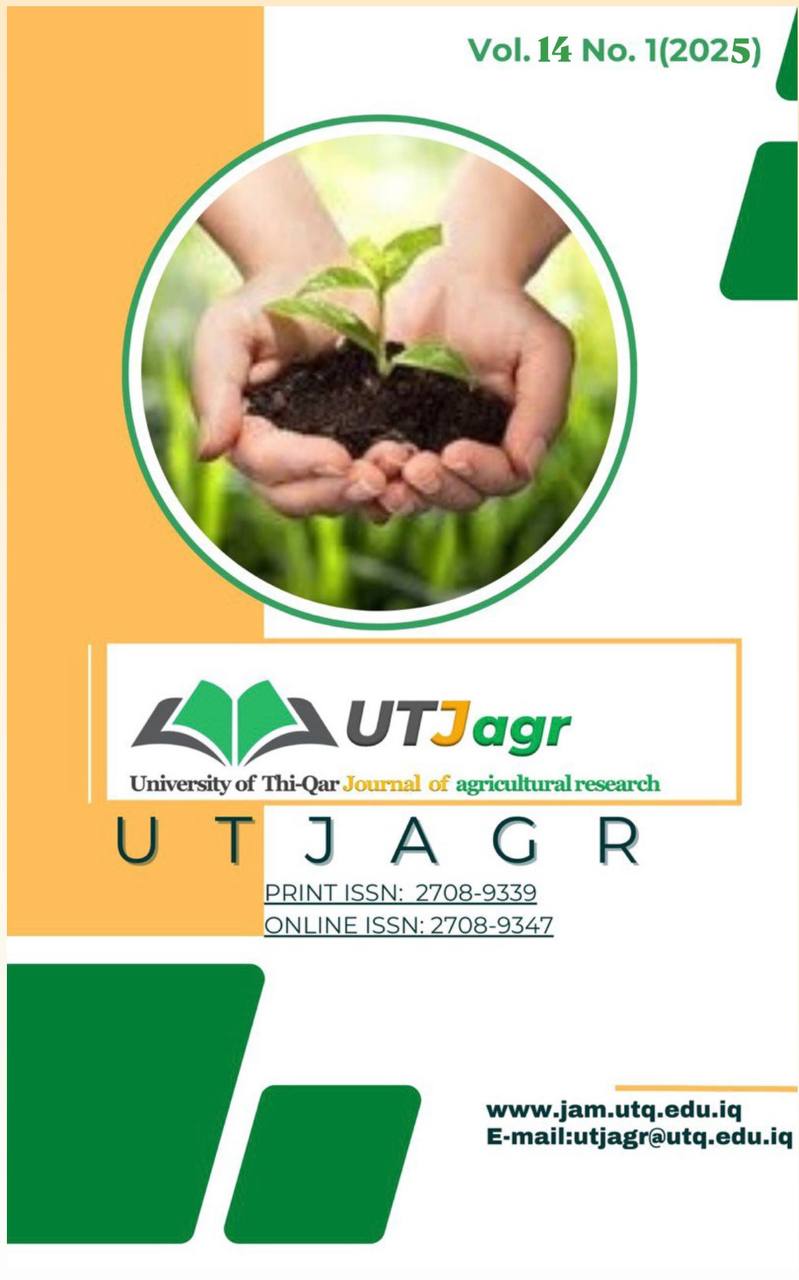Genetic Polymorphism of the DCT gene in local ducks raised in Iraq
DOI:
https://doi.org/10.54174/z7yh4w11Keywords:
Genetic Polymorphism; Plumage Color; DCT gene; local ducksAbstract
The study was conducted in the field of waterfowls birds breeding / College of Agriculture / University of Basrah during the period from 5/12/2023 to 1/30/2024, to detect the genetic polymorphism of the (DCT) gene. In this study (270 chicks from three genetic groups of local ducks were used according to the feather colours (white, gray) and mallard ducks with (90) chicks for each group. (25) blood samples were collected from each group at the age of (6) weeks. DCT gene amplification and DNA sequencing revealed four base-change sites (70T>C), (148C>T), (234G>A), and (370A>G) and a group of alleles associated with feather colour. The genotypes showed an equilibrium of different mutation sites, the genetic mutation (70T>C) was equilibrium in all feather colour groups of ducks, while the other genetic mutation (148C>T) is for ducks with gray and mallards, and the two genetic mutations (234G>A) for white and (370A>G) are in ducks with white and gray feathers. Shannon's index values increased for all mutation sites in local ducks. The frequencies of observed heterozygous genotypes were higher than the frequencies of observed homozygous genotypes, and negative values for the stability index were recorded for all mutation sites.
Downloads
References
Ahmadi, A. K., Rahimi, G., Vafaei, A., & Sayyazadeh, H. (2007). Microsatellite analysis of genetic diversity in Pekin (Anas platyrhynchos) and Muscovy (Cairina moschata) duck populations. International Journal of Poultry Science, 6(5), 378-382.
Ahmed, T. M., & Ameen, Q. A. (2024). Molecular characterization by two types of DNA markers for indigenous ducks in Kurdistan. Euphrates Journal of Agricultural Science, 16(1).
Al-Kurdi, M. A., Al-Shaheen, S. A., & Al-Asadi, M. H. (2019). Use of RAPD Markers Technique to Evaluate Genetic Variation in Two Types of Local Ducks. Basrah Journal of Agricultural Sciences, 32(2), 1-6.
Cherry, P., & Morris, T. R. (2008). Domestic duck production: science and practice. CABI.
FAO (Food and Agriculture Organization of the United Nations). (2014). Global Poultry Trends 2013: Record World Duck Meat Production in 2013, ISSN 0251-1959.
Hall, T. A. (1999). BioEdit: a user-friendly biological sequence alignment editor and analysis program for Windows 95/98/NT. Nucl. Acids. Symp. Ser. (No Title), 41, 95.
Hasina, S., Dong-Won, S., Hee–Bok, P., Muhammad, C., Shil, J., Rashedul, H. M., ... & Jun-Heon, L. (2015). Identification of Polymorphisms in Plumage Color Related Genes in Korean Native Ducks. Journal of the Faculty of Agriculture, Kyushu University, 60(1), 119-126.
Huang, Y., Li, Y., Burt, D. W., Chen, H., Zhang, Y., Qian, W., ... & Li, N. (2013). The duck genome and transcriptome provide insight into an avian influenza virus reservoir species. Nature genetics, 45(7), 776-783.
Li, S., Wang, C., Yu, W., Zhao, S., & Gong, Y. (2012). Identification of genes related to white and black plumage formation by RNA-Seq from white and black feather bulbs in ducks. PLoS One, 7(5), e36592.
Miffaf (Ministry for Food, Agriculture, Forestry). (2013). Primary Statistics of food, Agricultuer, Forestry and Fisheries, Sejong, Korea.
NRC, National Research Council. (1994). Nutrient Requirements of Poultry. 9th ed. National Academy of Science. Washington, DC., USA.
PADHI, M. K., GIRI, S. C., & SAHOO, S. K. (2022). Genetic characterization for growth traits and performance of Kuzi ducks being selected for higher eight-week body weight. Sharma R, Kishore A, Mukesh M, Ahlawat S, Maitra A, Padhi, M. K., Giri, S. C., Sastry, K. V. H., Sahoo, S. K., Bais, R. K. S., & Saxena, V. K. (2022). Genetic and phenotypic characterization of Kuzi ducks of Odisha and evaluation of carcass quality. Indian Journal of Animal Sciences, 92(2), 196-201.
Sultana, H., Dong-won, S., Hee-Bok, P., Mohammad, C., Shil, J., Rashedul, H., Yeon-Su, K., Kang-Nyeong, H., Takafumi, G., and Jun-Heon, L. (2014). Identification of polymorphisms in plumage color related genes in Korea Native Ducks. J. Fac. Agr., Kyushu Univ., 60(1),119-126.
Sultana, H., Seo, D. W., Park, H. B., Cahyadi, M., Jin, S., Hoque, M., ... & Lee, J. H. (2015). Identification of polymorphisms in plumage color related genes in Korean native ducks.
Sultana, H., Seo, D., Choi, N. R., Bhuiyan, M. S. A., Lee, S. H., Heo, K. N., & Lee, J. H. (2018). Identification of polymorphisms in MITF and DCT genes and their associations with plumage colors in Asian duck breeds. Asian-Australasian journal of animal sciences, 31(2), 180. Tubelyte, V., Švažas, S., Sruoga, A., Butkauskas, D., Paulauskas, A., Baublys, V., ... & Kozulin, A. (2011). Genetic diversity of tufted ducks (Aythya fuligula, Anatidae) in Eastern Europe. Central European Journal of Biology, 6(6), 1044-1053.
Tunca, R. I., Taskin, A., & Buyuk, M. (2015). Genetic analyses of some central anatolian domestic duck populations with inter simple sequence repeat (ISSR): A preliminary study.
Wang, Z., Guo, Z., Mou, Q., Liu, H., Liu, D., Tang, H., ... & Zhou, Z. (2024). Unique feather color characteristics and transcriptome analysis of hair follicles in Liancheng White ducks. Poultry Science, 103(7), 103794.
Wu, Y., Liu, X. L., Hou, S. S., & Huang, W. (2008). Study on genetic diversity of six duck populations with microsatellite DNA. Asian-Australasian journal of animal sciences, 21(6), 776-783.

Downloads
Published
Issue
Section
License
Copyright (c) 2025 Hussein Hussein Majeed Shareef, Sajida. A. Al-Shaheen

This work is licensed under a Creative Commons Attribution-NonCommercial-ShareAlike 4.0 International License.







1.png)

